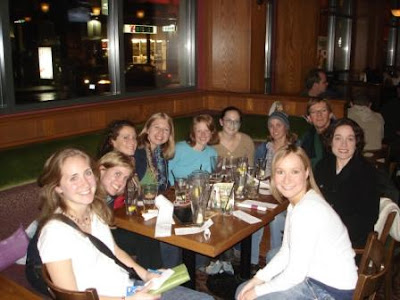 Entrance to Sololo School Library
Entrance to Sololo School Library
By Jamie Hancock, MLIS There is no weekly garbage pick-up in The Gambia. Mornings are never quiet – always beginning with the morning prayer call at 5 am from the loudspeakers of the mosque, followed shortly thereafter by the crows of roosters, the clucking of hens, and the chirping of chicks.
But they are never interrupted by the rude mechanical noise of a garbage truck, abruptly stopping with a large hydraulic sigh and lowering its talons to scoop up a dumpster. Nor will you see a man in a jumpsuit stepping down from his vehicle to survey the latest offerings.
Dawn welcomes sanitation workers of a different sort. Goats, sheep, and stray dogs regularly wander into family compounds looking for edible scraps left over from last night’s dinner. With livestock roaming about, there is no need to place food waste in a plastic container. These animals are vigilant vacuum cleaners that scour the grounds daily.
Certainly this is a more reliable form of food disposal than weekly garbage service instituted in developed countries. Goats do not take public holidays off, and they often greet their customers with a friendly bleat.
Unfortunately, waste management is not limited to food items and even a large population of goats (given their reputation to eat anything) cannot be expected to consume millions of aluminum cans and double-A batteries. In The Gambia, there are three main methods of garbage disposal: littering, burning, or depositing trash in a latrine. People walking the streets generally discard their food wrappers or drink containers anywhere they please. Inside their home compounds, they may burn collected piles of trash. Household items that do not burn easily or safely, such as batteries, are dropped into the backyard latrine.
Now that you are familiar with the country’s sanitation practices, it may help you to understand how I stood in front of a pile of burning books one afternoon outside a grade school, in a state of perfect calm and with a sense of accomplishment. Or perhaps I should take a step back, before your mind draws connections with “Fahrenheit 451.”
During a two-week trip to visit my girlfriend in The Gambia over the winter holidays, I volunteered to help
volunteered to help
Boys of Sololo help with the weeding process.
organize and clean up the school library in the village of Sololo. This is one of perks of being a Peace Corps boyfriend – besides the obvious strain of a long-distance relationship.
Sololo is a small village located in the Central River District, about 318 km east of Banjul, the capital city. The village is home to dozens of family compounds, a mosque, a small store, and a primary school. Villagers yield some crops from the fields and gardens, but rely heavily on income gained from employment in the nearest city, Bansang. My girlfriend, Megan Svec, lives with a host family in a fenced compound of six mudbrick huts. Ebrima, her late host father, worked as an orderly at the hospital in Bansang. Since his passing, the family of two wives, six sons and two daughters has more or less split apart. No longer financially supported by their father, some of the family members have left Sololo to live with relatives and attend school in other towns. As it stands, the village primary school is generally regarded as a poor educational institution that provides little discipline or preparation for advanced schooling. Low-paying teaching jobs, lack of resources and corruption (as rumored by the school librarian) are a few reasons for the school’s substandard education.
Another contributing factor is the condition of the library. When I first visited the library in February, it was closed to students and the books were piled in no discernible fashion on two shelves and a wooden bench. Upon my return to Sololo in December, the library was still only available to faculty and the books were in a fixed state of disarray, gathering dust and offering homes for insects. The school principal would like to re-open the library to students and perhaps expand it to include a reading area. My girlfriend was enlisted to spearhead the organization effort, and I unwittingly became her partner in this venture. As a student of library and information science (albeit one academic quarter), I felt confident that I could implement innovative ideas to improve access to information and encourage literacy.
Within the far corners of these piles, there were books housing families of termites. Little white squirming bugs had discovered their private paradise: neglected copies of “Brave Tales of Adventure” and “Roger and the School Bus.” We killed the termites and swept them out of the library. We sorted partially or completely destroyed books into a pile for burning.
During the first day of this project, I realized some huge obstacles. Besides the absence of call numbers on each book and the lack of electricity (and thus computers) in the building, there were problems of adequate shelving space and book decay. Rows of books were piled behind rows of books on both shelves, and boxes of books lie beneath them. The shelves were packed as tightly as possible. There was no way imaginable to place all of the books with their spine facing out (to allow patrons to browse the stacks); not to mention, many of the children’s non-hardcover books did not have spines with titles.
 Burning damaged books in the back of the school.
Burning damaged books in the back of the school.
Within the far corners of these piles, there were books housing families of termites. Little white squirming bugs had discovered their private paradise: neglected copies of “Brave Tales of Adventure” and “Roger and the School Bus.” We killed the termites and swept them out of the library. We sorted partially or completely destroyed books into a pile for burning.
On the second day, a group of children wandering the school grounds poked their heads into the door of the library. What were two white strangers doing inside the library while school was not in service (on the week before the Muslim holiday of Tabaski)? My girlfriend asked them if they wanted to help, and in an instant, we had hired a library workforce (at a cost of a few used coloring books). The children pulled out the boxes from underneath the shelves and sorted damaged books into our garbage pile. At the end of the day, the kids hauled this pile into a field behind the school and lit it on fire. They controlled the burning by scooping handfuls of water from a bucket on the edges of the flames.
So far, I have detailed the weeding process, but most of our time was spent organizing the collection. Without a library catalog or labeling system, my girlfriend and I decided to sort the books into groups to facilitate easier browsing. On my earlier trip to Sololo in February, we had separated the textbooks from other books. This time around, we cre ated categories of non-fiction, beginner fiction,
ated categories of non-fiction, beginner fiction,
All children's literature was reviewed to determine reading level.
intermediate fiction, and advanced fiction. These divisions were largely arbitrary, based on our judgment of reading level, appropriate themes and amount of pictures. Within each category, we grouped books together in series such as “One, Two, Three and Away” and “Wide Range Readers.”
Most of the books in the library were published in the UK, because The Gambia is a former British colony and a member of the Commonwealth of Nations. I examined several books with content that seem totally unrelated to Gambian culture and customs. A reading guide titled “Dad’s Sunday” detailed the normal activities of a British family: “On Sunday morning my Dad likes to go out for a beer or two. He comes home, has his lunch and then goes to sleep. Usually he snores. He wakes up just in time to go out for his evening beer.” As most Gambians are Muslim and refrain from drinking alcohol, this guide is inappropriate for teaching reading comprehension. Yet, as a volunteer and an outsider to the village, I did not feel comfortable removing it from the collection.
At the end of two days, we had managed to sort hundreds of books into several categories. We had also removed damaged books and termites from the building. Sadly, I won’t get to see the next stage of development and organization. If the library is to serve its purpose as educating the schoolchildren, it needs expanded shelf space and more room for students to read and study the materials. Beyond physical improvements, teachers should encourage library use and make books outside the curriculum more available to students. If reading can’t be made pleasurable or easy, then children are less likely to learn. All parents, teachers, and librarians must understand this correlation, whether in Africa or America.
Jamie Hancock is studying to become a middle school librarian. He refuses to watch the Super Bowl because of an altercation earlier this year with Rex Grossman.
 Arboretum by David Byrne. 2006. McSweeney’s Books. www.davidbyrne.com. www.mcsweeneys.net. How do we perceive information? What associations with that info does our ever-churning brain create? Byrne’s compiled an intriguing book of his tree diagram drawings which he describes as “faux science, automatic writing, self-analysis, satire and maybe even a serious attempt at finding connections where none were thought to exist.” Byrne, legendary former lead singer and co-founder of the music group Talking Heads, has spent much of his life exploring stories, and
Arboretum by David Byrne. 2006. McSweeney’s Books. www.davidbyrne.com. www.mcsweeneys.net. How do we perceive information? What associations with that info does our ever-churning brain create? Byrne’s compiled an intriguing book of his tree diagram drawings which he describes as “faux science, automatic writing, self-analysis, satire and maybe even a serious attempt at finding connections where none were thought to exist.” Byrne, legendary former lead singer and co-founder of the music group Talking Heads, has spent much of his life exploring stories, and  started
started













